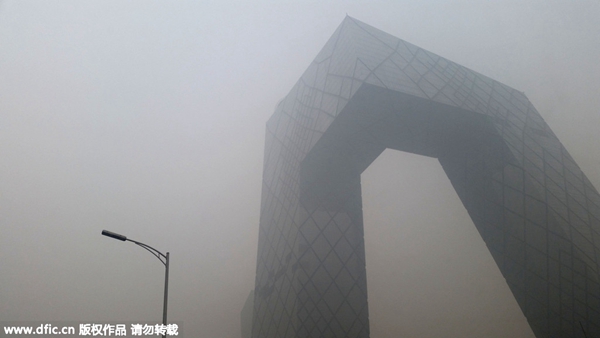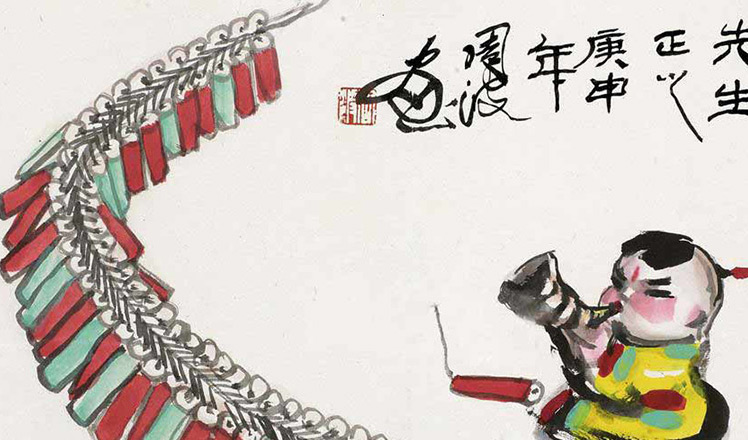New environmental guidelines shift focus, add two more air pollution targets
Updated: 2016-01-22 17:06
By Zheng Jinran(chinadaily.com.cn)
|
||||||||
 |
|
The China Central Television (CCTV) headquarters is obscured by severe smog in Beijing on Tuesday. [Photo/IC] |
China's new five-year national development plan shifts the country's environmental focus and expands by two the airborne pollutants targeted for reduction in an effort to control severe smog.
The 13th Five-Year Plan (2016-2020) will establish binding limits for volatile organic compounds and PM2.5, particulate matter with a diameter of less than 2.5 microns that is dangerous to human health.
The new guideline also will make environmental improvements a core goal, shifting the focus from merely controlling the emission of major pollutants, said Liu Bingjiang, head of the pollutants emission department at the Ministry of Environmental Protection.
It will require improvements in both environmental quality and the control of major pollutants, and the central government will assess staff performance based on achievements of both goals, Liu said on Thursday.
Local governments that reach their targets in reducing pollution emissions, while failing to improve environmental quality will face penalties, Liu said.
Wu Shunze, deputy head of the Chinese Academy of Environmental Planning, an environmental think tank, said the 13th Five-Year Plan also initiates a new chapter for environmental protection.
The focus on improving environmental quality provides a framework for future pollution controls that individualize the mission for different regions based on their distinct situations, Wu said.
For example, the target for airborne pollutants requires all cities to reach the national standards on sulfur dioxide and carbon monoxide by the end of 2020, Wu said. It would take 15 years for the three major industrial clusters that suffer the worse air pollution — the Pearl River Delta, the Yangtze River and the Beijing-Tianjin-Hebei region — to reach the national healthy air quality standards.
The country also will see the improvement in water and soil quality after a series of strengthened efforts during the 13th Five-Year Plan period, Wu said.
Despite the achievements made in cutting noxious emissions by major polluting industries, growth in emissions from vehicles and other sources like outdoors barbecues have offset the industrial reductions.
The new binding limits on VOC and PM2.5 join previous targets on the reduction of sulfur dioxide, nitrogen oxides, chemical oxygen and ammonia nitrogen, which all governments reached during the 12th Five-Year Plan period (2010-15), the ministry said.
The reduction of the four pollutants were mainly achieved through installing facilities and improved technologies to reduce the emissions from major polluters and the phasing out of outdated companies, but it hasn't been enough to drive the overall needed improvements, Liu said.
- Microsoft, IBM eye technology to forecast air pollution in China
- Hebei to meter central heating to curb air pollution
- Beijing issues blue alert for heavy air pollution
- Air pollution jumped to alarming levels last month
- Beijing's first air pollution red alert puts public transportation under pressure
- A glimpse of Spring Rush: little migrant birds on the way home
- Policy puts focus on genuine artistic students
- Police unravel market where babies are bought, sold as commodities
- More older pregnant women expected
- Netizen backlash 'ugly' Spring Festival Gala mascot
- China builds Mongolian language corpus
- 2 Chinese nationals killed, 1 injured in suspected bomb attack in Laos
- New York, Washington clean up after fatal blizzard
- 'Plane wreckage' found in Thailand fuels talk of missing Malaysian jet
- Washington shuts down govt, NY rebounds after blizzard
- 7 policemen, 3 civilians killed in Egypt's Giza blast
- Former US Marine held in Iran arrives home after swap

 Drone makers see soaring growth but dark clouds circle industry
Drone makers see soaring growth but dark clouds circle industry China's Zhang reaches Australian Open quarterfinals
China's Zhang reaches Australian Open quarterfinals
 Spring Festival in the eyes of Chinese painters
Spring Festival in the eyes of Chinese painters
 Cold snap brings joy and beauty to south China
Cold snap brings joy and beauty to south China
 The making of China Daily's Tibetan-style English font
The making of China Daily's Tibetan-style English font
 First trains of Spring Festival travel depart around China
First trains of Spring Festival travel depart around China
 Dough figurines of Monkey King welcome the New Year
Dough figurines of Monkey King welcome the New Year
 Ning Zetao, Liu Hong named China's athletes of the year
Ning Zetao, Liu Hong named China's athletes of the year
Most Viewed
Editor's Picks

|

|

|

|

|

|
Today's Top News
National Art Museum showing 400 puppets in new exhibition
Finest Chinese porcelains expected to fetch over $28 million
Monkey portraits by Chinese ink painting masters
Beijing's movie fans in for new experience
Obama to deliver final State of the Union speech
Shooting rampage at US social services agency leaves 14 dead
Chinese bargain hunters are changing the retail game
Chinese president arrives in Turkey for G20 summit
US Weekly

|

|







